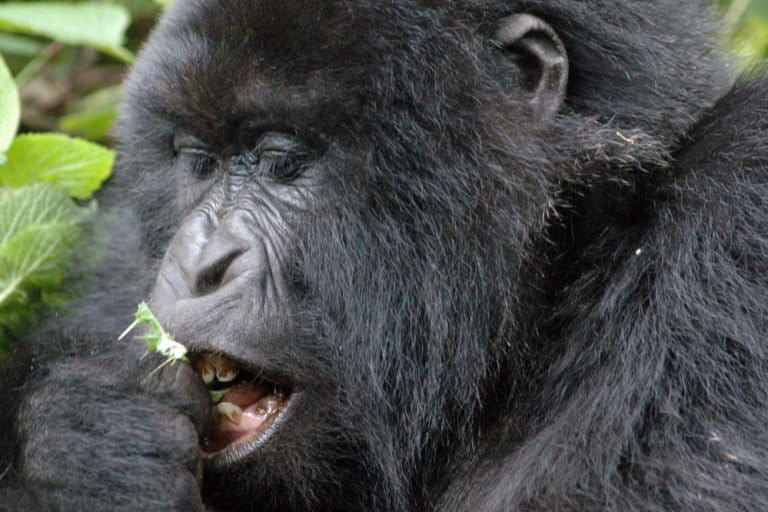- For three years in a row, Virunga National Park in the eastern Democratic Republic of Congo (DRC) has been reporting new births in gorilla families.
- According to park officials, the baby boom is thanks to conservation efforts in Virunga that have promoted wildlife development.
- Conservationists warn that armed groups in the park still pose a threat to gorillas, as do moves to reclassify parts of protected areas for mining.
As a clear morning dawned on May 18, 2021, a baby was born. She was a gorilla, born to the Mapuwa family, one of 10 gorilla families in Virunga National Park, in the eastern Democratic Republic of Congo. A month later, news broke that another gorilla, Mafuko from the Bageni family, was born on June 6 in the park.
At least nine gorillas have been born in Virunga since January.
Since 1996, consecutive civil wars in the DRC have taken their toll on animals in this region. Gorillas have been among the victims of these crises, in particular as soldiers hunt them for their meat.
Challenges persist despite ‘baby boom’
The Congolese Institute for Nature Conservation (ICCN) estimates that more than 350 gorillas live in the protected areas of Virunga, Kahuzi-Biega and Maiko in the eastern DRC.
These include eastern lowland gorillas (Gorilla beringei graueri), also known as Grauer’s gorillas, and mountain gorillas (Gorilla beringei beringei). These gorillas face a triple threat: the destruction of their natural habitat by deforestation, danger from local and foreign armed groups in protected areas, and poaching encouraged by the illegal trade in baby gorillas.
“There has always been criticism of the insufficient animal protection, including for gorillas, in Virunga National Park, due to the presence of armed groups,” said Joseph T’hata, a lawyer and environmental safety researcher. “Armed groups like the Mai-Mai militias or the Rwandan Hutu rebels of the FDLR [Democratic Forces for the Liberation of Rwanda] have control both in and outside the park, and also make a living from poaching and the illegal animal trade.”
“In the past, gorillas faced poaching threats from people who collected baby gorillas on the pretext of reselling them in zoos in the West,” said eco-guard Jacques Katutu, who monitors gorillas in Virunga National Park.
Faced with these challenges, Virunga has decided to step up patrols and ensure close monitoring by carrying out regular censuses. Almost every year, the park recruits young eco-guards from neighboring communities, who are trained to monitor the flora and fauna of this protected area of more than 790,000 hectares (1.95 million acres).
Katutu has been monitoring gorillas for 10 years, and remains convinced that it is these mechanisms that have led to the new gorilla baby boom in Virunga.
“In 2020, we recorded more births than in previous years. We reached 18 new births while the annual Virunga average is 12 births. We even recorded a second set of twins, after our first set was born in 2016,” Katutu said. “These are the only two cases of twins that have ever been recorded in Virunga.
“We started recording births after forming teams of eco-guards and trackers to closely monitor the gorillas, but also since setting up the system of guarding gorillas morning, noon and evening and stepped up the census,” he added. “All this helped us until the conservation status of gorillas changed.”

Moving up the red list
In 2018, the IUCN, the global conservation authority, updated its Red List of Threatened Species, moving mountain gorillas from critically endangered to endangered — an improvement attributed to the efforts in great ape conservation. But we shouldn’t celebrate too quickly, said T’hata, author of a book on the armed groups present in Virunga National Park.
“As long as there are still armed groups in the park, the threat persists. The threat is greater than the eco-guards’ ability to protect gorillas,” T’hata said. “Today, eco-guards die regularly because they are ambushed by militiamen.”
Katutu said the poaching problem must be tackled to safeguard the future of gorillas.
“Thanks to our conservation efforts, we have seriously fought back against poachers targeting baby gorillas. But as long as any poaching continues, it still poses a threat to gorillas,” he said. “Baby gorillas can still die by falling into traps placed in gorilla habitats intended for other animals. We need intense monitoring and clearing operations to remove traps so we can prevent gorilla fatalities.”
Not just poaching
In 2018, Greenpeace noted that threats to gorillas are not solely linked to poaching.
“We want to highlight that threats to these great apes remain and even increased in 2018, due in particular to the decision of the Congolese government to declassify and decommission part of Virunga National Park, a sanctuary for mountain gorillas in eastern DRC, for the benefit of oil exploitation,” said Raoul Monsembula, Central Africa regional coordinator for Greenpeace Africa.
Banner image of a female mountain gorilla watching an infant by Geordie Mott via Flickr (CC BY-NC-ND-2.0).
This story was reported by Mongabay’s French team and first published here on our French site on June 10, 2021.
